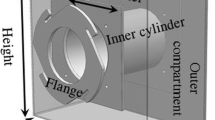Abstract
The possible role of adrenergic mechanisms in thermoregulatory changes in the partition of femoral blood flow between nutrient (capillary) and non-nutrient (arteriovenous anastomoses, AVA) circuits in the hind limb of conscious sheep has been investigated employing radioactive microsphere and electromagnetic blood flow measurement techniques. Constriction of AVAs, normally induced by spinal cooling, could be inhibited by phentolamine, whereas dilatation of AVAs, noramally induced by spinal heating, could be inhibited by noradrenaline or methoxamine. AVA constriction could be induced by noradrenaline or methoxamine, or dialation by phentolamine. Isoprenaline had a small dilator and propranolol a small constrictor effect on AVAs. It is concluded that adrenergic pathways involving predominantly α-receptors play a role in thermoregulatory changes in skin blood flow (through AVAs) elicited by manipulation of CNS temperature; under these conditions, β-receptors do not play any role, although manipulation of their activity will influence AVAs under non-thermoregulatory conditions. Capillary blood flows in skin, bone and fat were sensitive, at different ambient temperatures and to varying degrees, to some α-and β-adrenergic agents.
Similar content being viewed by others
References
Alexander G (1979) Cold thermogenesis. In: Robertshaw D (ed) Environmental physiology III. International review of physiology, vol 20. University Park Press, Baltimore, pp 43–155
Foldes A, Hales JRS (1981) Adrenergic involvement in thermal control of capillaries and arteriovenous anastomoses in skin. In: Garlick D (ed) Progress in microcirculation research. CPME University of NSW, Sydney, pp 329–336
Hales JRS (1974) Physiological responses to heat. In: Robertshaw D (ed) MTP international review of science, physiology. Series 1, pp 107–162
Hales JRS (1980) Paradoxical effects of temperature of skin arteriovenous anastmoses. In: Szelényi Z, Székely M (eds) Contributions to thermal physiology. Akadémiai Kiadó, Budapest, pp 383–385
Hales JRS (1982) Thermoregulatory requirements for regional circulatory adjustments to promote heat loss in animals. J Thermal Biol (in press)
Hales JRS, Cliff WJ (1977) Direct observations on the behaviour of microspheres in microvasculature. Bibl Anat 15:87–91
Hales JRS, Iriki M (1975) Integrated changes in regional circulatory activity evoked by spinal cord and peripheral thermoreceptor stimulation. Brain Res 81:267–279
Hales JRS, Johnson KG (1981) Relationship between vascular and sweating responses to drugs in isolated skin. J Physiol 313:19P
Hales JRS, Fawcett AA, Bennett JW (1978a) Radioactive microsphere measurement of the partition of bloodflow between capillaries and arteriovenous anastomoses in skin of sheep. Pflügers Arch 376:87–91
Hales JRS, Fawcett AA, Bennett JW, Needham AD (1978b) Thermal control of bloodflow through capillaries and arteriovenous anastomoses in skin of sheep. Pflügers Arch 378:55–63
Hales JRS, Iriki M, Tsuchiya K, Kozawa E (1978c) Thermally induced cutaneous sympathetic activity related to bloodflow through capillaries and arteriovenous anastomoses. Pflügers Arch 375:17–24
Johansen K, Millard RW (1974) Cold induced neurogenic vasodilatation in skin of the giant fulmar,Macronectes giganteus. Am J Physiol 227:1232–1235
Krönert H, Wurster RD, Pierau FR-K, Pleschka K (1980) Vasodilatory responses of arteriovenous anastomoses to local cold stimuli in the dog's tongue. Pflügers Arch 388:17–19
Lunde PKM, Michelsen K (1970) Determination of cortical blood flow in rabbit femur by radioactive microspheres. Acta Physiol Scand 80:39–44
McGregor DD (1979) Non-cholinergic vasodilator innervation in the feet of ducks and chickens. Am J Physiol 237:H112-H117
Midtgard U, Bech C (1981) Responses to catecholamines and nerve stimulation of the perfusedrete tibiotarsale and associated blood vessels in the hind limb of the Mallard. Acta Physiol Scand 112:77–81
Millard RW, Reite OB (1975) Peripheral vascular response to norepinephrine at temperatures from 2 to 4°C. J Appl Physiol 38:26–29
Milnor WR (1968) In: Mountcastle VB (ed) Medical physiology. Mosby, St Louis, p 236
Molyneux GS (1977) The role of arteriovenous anastomoses in the peripheral circulation. Proceedings of the Royal Society of Queensland 88:5–14
Molyneux GS, Hales JRS (1979) Histological evidence for the involvement of noradrenergic transmission in control of cutaneous arteriovenous anastomoses. Proc Aust Physiol Pharmacol Soc 80:63
Molyneux GS, Hales JRS (1982) The use of ultrastructural and histochemical techniques to correlate sympathetic activity with blood flow through cutaneous arteriovenous anastomoses in conscious sheep. Microcirc Clin Exp 1:41–53
Murrish DE, Guard CL (1977) Cardiovascular adaptations of the giant petrel,Macronectes giganteus, to the Antarctic environment. In: Llano GA (ed) Adaptations within Antarctic ecosystems. Smithsonian Institute, Washington, p 551
Oddy VH, Brown BW, Jones AW (1981) Measurement of organ blood flow using tritiated water. I. Hindlimb muscle blood flow in conscious ewes. Aust J Biol Sci 34:419–425
Piiper J, Schurmeyer E (1955) Über den Einfluß von Doryl und Histamin auf die arteriovenösen Anastomosen in der Hundeextremität. Pflügers Arch 261:234–242
Rowell LB (1977) Reflex control of cutaneous vasculature. J Invest Dermatol 69:154–166
Schoutens A, Bergmann P, Verhas M (1979) Bone blood flow measured by85Sr microspheres and bone seeker clearances in the rat. Am J Physiol 236:H1–6
Schönung W, Wagner H, Simon E (1972) Neurogenic vasodilatory component in the thermoregulatory skin blood flow response of the dog. Naunyn-Schmiedeberg's Arch Pharmacol 273:230–241
Spence RJ, Rhodes BA, Wagner HW Jr (1972) Regulation of arteriovenous anastomotic and capillary blood flow in the dog leg. Am J Physiol 222:326–332
Taylor SH, Sutherland GR, MacKenzie GJ, Staunton HP, Donald KW (1965) The circulatory effects of phenolamine in man with particular respect to changes in forearm blood flow. Clin Sci 28:265–284
Thomson EM, Pleschka K (1980) Vasodilatory mechanisms in the tongue and nose of the dog under heat load. Pflügers Arch 387:161–166
Vanhoutte PM, Leusen I (1978) Mechanisms of vasodilatation. Raven, New York
Walther O, Iriki M, Simon E (1970) Cutaneous and visceral sympathetic activity during spinal cord heating and cooling in anaesthetized rabbits and cats. Pflügers Arch 319:162–184
Author information
Authors and Affiliations
Rights and permissions
About this article
Cite this article
Hales, J.R.S., Foldes, A., Fawcett, A.A. et al. The role of adrenergic mechanisms in thermoregulatory control of blood flow through capillaries and arteriovenous anastomoses in the sheep hind limb. Pflugers Arch. 395, 93–98 (1982). https://doi.org/10.1007/BF00584720
Received:
Accepted:
Issue Date:
DOI: https://doi.org/10.1007/BF00584720



